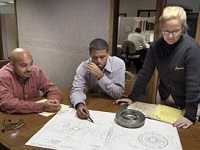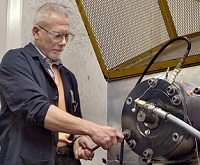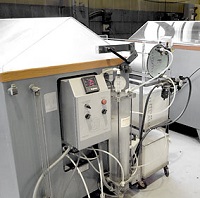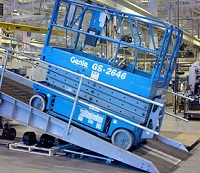Clean-sheet Engineering Philosophy
 Ausco's brake designs solve customer problems and make it easier for you to develop the best possible equipment. Using our clean-sheet engineering philosophy, we'll create and supply a complete package that meets your specific needs for performance and reliability.
Ausco's brake designs solve customer problems and make it easier for you to develop the best possible equipment. Using our clean-sheet engineering philosophy, we'll create and supply a complete package that meets your specific needs for performance and reliability.
This inventive engineering philosophy has made us a leader in braking technologies, with a steady flow of new product launches and patents every year to prove it.
We have invested heavily in our research and development laboratory. Our test equipment includes:
 • Brake dynamometer testing — With torque capacities up to 100,000 in-lbs and energyThumbnail image capacities as high as 1,000,000 ft-lbs, these machines can simulate dynamic vehicle braking conditions. The machines are fully instrumented to measure torque, apply pressure and temperature in real time. They can be used for wear testing, durability testing, dynamic response testing and static torque testing.
• Brake dynamometer testing — With torque capacities up to 100,000 in-lbs and energyThumbnail image capacities as high as 1,000,000 ft-lbs, these machines can simulate dynamic vehicle braking conditions. The machines are fully instrumented to measure torque, apply pressure and temperature in real time. They can be used for wear testing, durability testing, dynamic response testing and static torque testing.
• Pressure cycle testing — With pressure capability up to 4,000 psi, our hydraulic cycle stand allows us to test our products for durability and fatigue in high-cycle-life applications. The stand can independently cycle up to eight brakes at a time at any pressure or cycle interval we choose.
• Radial and axial bearing load testing — Many of our brakes include load-carrying bearings and have to meet customer-specified bearing load parameters. Our bearing side load stand gives us the ability to apply high loads to rotating shafts for extended periods of time while evaluating our bearing and shaft designs.
 • Parasitic windage loss testing — In many applications, Thumbnail imagebrake drag in the free running state is a potential issue. To manage this issue, Ausco performs windage loss testing. This stand has the capability to measure drag torque at speeds up to 5,000 rpm. It can measure brake temperatures at multiple locations in the brake in real time. The data generated can be used to calculate power loss and simulate actual vehicle operating conditions addressing drag problems on your machine even before the first brake is assembled to the vehicle.
• Parasitic windage loss testing — In many applications, Thumbnail imagebrake drag in the free running state is a potential issue. To manage this issue, Ausco performs windage loss testing. This stand has the capability to measure drag torque at speeds up to 5,000 rpm. It can measure brake temperatures at multiple locations in the brake in real time. The data generated can be used to calculate power loss and simulate actual vehicle operating conditions addressing drag problems on your machine even before the first brake is assembled to the vehicle.
• Static torque testing — Most brakes have a parking or static holding requirement. Ausco has two static torque test stands with 20,000 and 100,000 in-lbs capacities for this purpose.

• Salt spray and humidity chamber testing — Corrosion is aThumbnail image fact of life in all off-highway applications. Ausco has both salt spray and humidity chamber testing for just this purpose.
• Environmental chamber — Our brakes are often subjected to temperature extremes. Thus, we have an environmental test chamber that can test brakes between -90F and 300F. The environmental chamber also has external heating and cooling chambers. With these chambers, brakes can be tested at various temperatures on the windage stand, the dynamometer or even on the cycle stand. In addition, the environmental chamber can be connected to our whole vehicle test box, allowing an entire vehicle to be soaked to a desired temperature. With this equipment, we can test our brakes for seal problems, bearing issues, windage losses at low temperature, on-vehicle braking performance or oil degradation.
 • Internal cavity inspection — As is the case with many enclosed designs, it is often hard to diagnose problems internal to brakes. You can't see what is actually going on inside a brake housing from the outside. To alleviate this problem, Ausco has a borescope with a video recording capability. With this device, Ausco can actually watch what is going on inside a brake in real time. Flow paths for oil can be tracked, small internal features can be inspected and unusual mechanical problems diagnosed.
• Internal cavity inspection — As is the case with many enclosed designs, it is often hard to diagnose problems internal to brakes. You can't see what is actually going on inside a brake housing from the outside. To alleviate this problem, Ausco has a borescope with a video recording capability. With this device, Ausco can actually watch what is going on inside a brake in real time. Flow paths for oil can be tracked, small internal features can be inspected and unusual mechanical problems diagnosed.
• Vehicle testing — Many of our customers simply don't have the time to fine-tune a new brake to their vehicle. In many cases, Ausco can help. We often develop total braking solutions for our customers on the vehicle. eng e thumbWe will obtain a vehicle, design brakes to fit it, prototype the brakes and their installation, modify linkages and hydraulics as needed and test the new brake on the vehicle. We have a slope test ramp to insure conformance to parking requirements, test tracks (both inside and outside) to perform dynamic stopping tests and even a mud bog to simulate the roughest of braking conditions.
Design Verification Plan and Report
We test our products to insure they comply with established braking performance and structural requirements. We create a test plan and report, called a DVP&R, as soon as the product is designed, and continue to update it throughout the product development process. When we are done testing a product, the DVP&R acts as a record of the testing and verification performed on a product, when the testing was performed and whether or not the product passed.
Cost Analysis and Reduction
In order to deliver well-engineered brakes at a reasonable cost, we are proactive in reducing costs through process and design improvements and good sourcing tactics. A cost reduction team meets regularly to improve Ausco's cost effectiveness on new projects and current production brakes.
Technical Sales Force
Unlike many companies, our sales people are not just people who call on you and show you brochures. Most of our sales people are degreed engineers; all are very technically oriented. They understand brake engineering and serve a vital function in understanding your concerns and needs. In addition, our product engineering staff often travels with our sales force, putting our design capability face-to-face with your engineering people. The advantage of having a customer-driven engineering and sales force creates a powerful collaboration for our customers. Your needs are understood up front. We design the correct product with the right price and performance for your application.
Source: http://www.auscoproducts.com/about/engineering